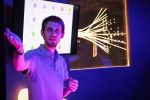 After a short introduction on the infinitely large and the infinitely small, visitors are guided through the different spaces where they are invited to interact with researchers, engineers and technicians of the laboratory. Scientists use the tools of their choice (multimedia content, models, technical installations, etc.) to address each theme.
After a short introduction on the infinitely large and the infinitely small, visitors are guided through the different spaces where they are invited to interact with researchers, engineers and technicians of the laboratory. Scientists use the tools of their choice (multimedia content, models, technical installations, etc.) to address each theme.
Introduction You are sitting under a tree in the warmth of a summer night," begins the guide, "in this scene of ordinary life there is an unknown physical phenomenon: elemental particles pass through you all the time." Their multiple facets are the subject of research in the laboratory.
 Matter/Antimatter
One of them is particularly confusing. To each constituent particle of matter corresponds an antiparticle which differs from the first only in its electrical charge. While matter is common in the universe, antimatter is very difficult to observe. In order to discover the reason for this, various means have been deployed by the LAPP. One of them is the LHCb experiment, the model of which is displayed at the beginning of the visit.
Matter/Antimatter
One of them is particularly confusing. To each constituent particle of matter corresponds an antiparticle which differs from the first only in its electrical charge. While matter is common in the universe, antimatter is very difficult to observe. In order to discover the reason for this, various means have been deployed by the LAPP. One of them is the LHCb experiment, the model of which is displayed at the beginning of the visit.
 Elementary particles
Among elementary particles, the famous Higgs boson was discovered at CERN in 2012 and earned his father Peter Higgs a Nobel Prize a year later. LAPP was a major player in this discovery through the construction of the ATLAS detector and the analysis of the data it generated. The exploitation of these data required the creation of a digital platform - known as MUST - which is now used by other laboratories at the University of Savoie Mont Blanc. New challenge for the LAPP: to produce a pair of Higgs bosons in order to validate the theoretical physics model.
Elementary particles
Among elementary particles, the famous Higgs boson was discovered at CERN in 2012 and earned his father Peter Higgs a Nobel Prize a year later. LAPP was a major player in this discovery through the construction of the ATLAS detector and the analysis of the data it generated. The exploitation of these data required the creation of a digital platform - known as MUST - which is now used by other laboratories at the University of Savoie Mont Blanc. New challenge for the LAPP: to produce a pair of Higgs bosons in order to validate the theoretical physics model.
 Violent universes
Light is made up of particles called photons. These are tracked by numerous observation devices, including soon the hundred or so telescopes of the CTA network. The design of these telescopes, specialized in gamma-ray detection, earned the LAPP the prestigious CNRS Collective Crystal Award this year. Through this project, we are invited to dive into the cosmos, a place where the most violent phenomena take place, such as the collision of neutron stars. This type of event causes a distortion of space-time in the form of gravitational waves. These were first observed by the Virgo device in 2017.
Violent universes
Light is made up of particles called photons. These are tracked by numerous observation devices, including soon the hundred or so telescopes of the CTA network. The design of these telescopes, specialized in gamma-ray detection, earned the LAPP the prestigious CNRS Collective Crystal Award this year. Through this project, we are invited to dive into the cosmos, a place where the most violent phenomena take place, such as the collision of neutron stars. This type of event causes a distortion of space-time in the form of gravitational waves. These were first observed by the Virgo device in 2017.
 Dark matter and dark energy
Finally, to finish this incursion into the invisible world, a last space deals with the enigmatic theme of dark matter. Ordinary matter represents only 5% of what the universe contains. The rest is made up of 27% dark matter (which is responsible for the formation of large massive structures) and 68% dark energy. Through the observation of galaxies, the laboratory hopes to unlock the secrets of these dark matter and dark energy. A virtual reality animation allows a better understanding of this theme.
Dark matter and dark energy
Finally, to finish this incursion into the invisible world, a last space deals with the enigmatic theme of dark matter. Ordinary matter represents only 5% of what the universe contains. The rest is made up of 27% dark matter (which is responsible for the formation of large massive structures) and 68% dark energy. Through the observation of galaxies, the laboratory hopes to unlock the secrets of these dark matter and dark energy. A virtual reality animation allows a better understanding of this theme.
Two types of routes are proposed by the guides according to the target public (20-30mn for the general public during the Science Festival, about 1h30 for school children). Visits are done in groups of about ten people.
A visit to the high-performance computing and storage centre, called MUST, can also be proposed.
For more information or to schedule a visit, please contact us.















